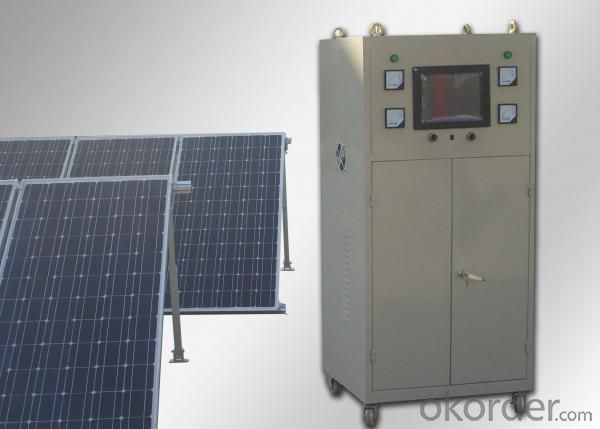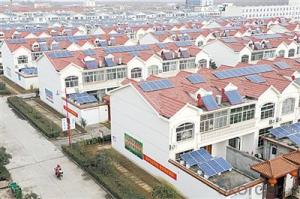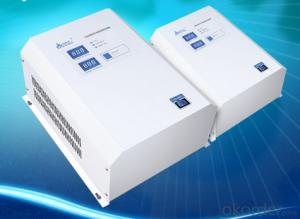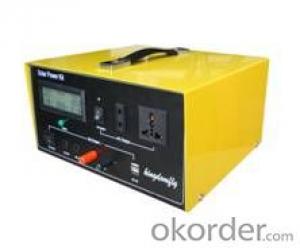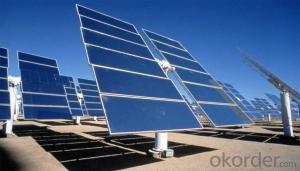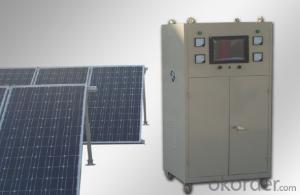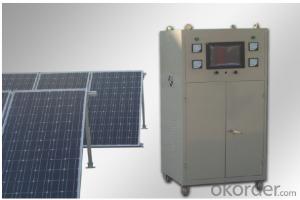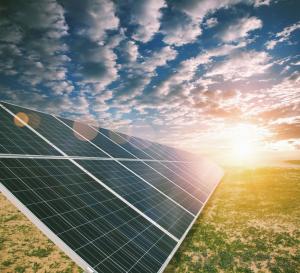Solar Energy Systems Maryland - CNBM Solar Home System CNBM-K8 (5kW)
- Loading Port:
- China Main Port
- Payment Terms:
- TT or L/C
- Min Order Qty:
- 1 set set
- Supply Capability:
- 1000 sets per month set/month
OKorder Service Pledge
OKorder Financial Service
You Might Also Like
Brief Introduction of Solar Energy System CNBM-K8 (5KW)
CNBM Home System-K8 (5KW) has a wonderful capacity.It can be used in factory,home,school and other CNBM Home System-K8 (5KW) consist of the solar modules,charge controller,inverter and battery banks.
CNBM International is highly recognized by its business partners and clients all over the world and has obtained rapid development under the spirit of win-win .
With CNBM Home System-K8 (5KW),
We will carry on the mutual beneficial,innovative and revolutionary trading structure as we did before,create value for our employees,share holders and clients and benefit the whole society in our future development.Please contact us ,if you have interest in CNBM Home System-K8 (5KW),don’t hesitate!
The Sketching of Solar Energy System CNBM-K8 (5KW)
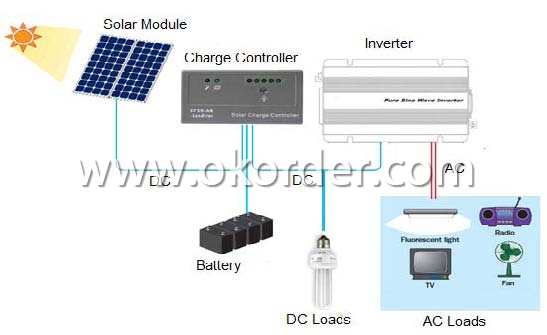
Components of Solar Energy System CNBM-K8 (5KW)
PV Array:
Convert sunlight instantly into DC electric power. Formed by the solar modules (also called photovoltaic modules) in accordance with the system requirements for series and parallel.
Solar Charge Controller:
A charge controller may be used to power DC equipment with solar panels. The charge controller provides a regulated DC output and stores excess energy in a battery as well as monitoring the battery voltage to prevent over charge or over discharge. An inverter can be connected to the output of a charge controller to drive AC loads.
Inverter:
Converts DC output power of photovaltaic soalr panels into standard AC power for use in the local off-grid electrical network. It is a critical component in a photovoltaic system, allowing the use of ordinary commercial appliances.
Battery banks:
Stores energy when there is an excess coming in and distribute it back out when there is a demand. Solar PV panels continue to re-charge batteries each day to maintain battery charge.
Technical data of Solar Home System CNBM-K8 (5KW) | ||
Inverter | Rated load power | 5000W |
Output wave | Pure sine wave | |
Output voltage | DC 110V | |
Output frequency | DC:110V AC:220V | |
Precision of output | 50HZ/60HZ | |
Precision of output frequency | ±6% | |
Solar panel | Pmax | 210W*24PCS |
Vmp | 27.3V*6 | |
Imp | 7.7A*4 | |
Charger | Charger voltage & current | 110V 50A |
Battery | Capacity | 12V 150AH*9*2PCS |
Power box | Spray paint iron box,with input,output,ammeter,voltmeter,master swith and so on. | |
Package of Solar Home System CNBM-K8 (5KW) | ||||
Part | Size(L*W*H mm) | Weight(kg) | 20’(pcs) | 40’(pcs) |
Power box | 840*620*1150 | 140 | 12 Sets | 15 Sets |
Solar panel | 1610*830*100 | 450 | ||
Battery | 1100*520*650*2 | 1100 | ||
Factory Picture of Solar Energy System CNBM-K8 (5KW)

Package Picture of Solar Energy System CNBM-K8 (5KW)
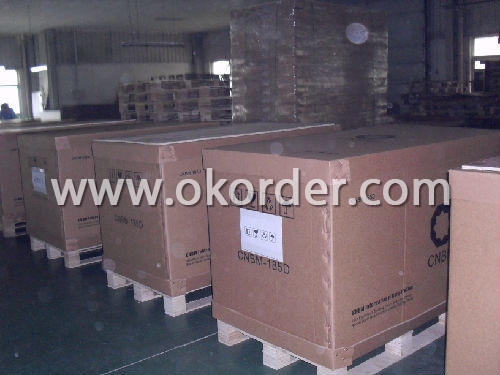
- Q: Do solar energy systems require regular panel replacements?
- No, solar energy systems do not require regular panel replacements. Solar panels are designed to be durable and can last for decades with proper maintenance.
- Q: Can solar energy systems be used for powering RVs?
- Yes, solar energy systems can be used to power RVs. Solar panels can be installed on the roof of an RV to capture sunlight and convert it into electricity, which can then be used to power various appliances and systems within the vehicle. This provides a sustainable and cost-effective way of generating power while on the road, reducing the reliance on traditional fuel sources and reducing carbon emissions.
- Q: How do solar energy systems affect air conditioning costs?
- Solar energy systems can significantly reduce air conditioning costs as they generate electricity from the sun, offsetting the need for traditional energy sources. By harnessing solar power, homeowners can power their air conditioning units without relying heavily on the grid, resulting in lower energy bills and decreased dependence on fossil fuels.
- Q: Can solar energy systems be used for powering electric boats or yachts?
- Solar energy systems have the capability to power electric boats or yachts. By installing solar panels on the boat's roof or deck, sunlight can be captured and converted into electricity. This electricity is then utilized to operate the boat's propulsion system and other electrical equipment on board. The popularity of solar-powered electric boats or yachts is increasing due to their environmentally friendly nature and the potential for fuel cost savings. However, the effectiveness of solar power in powering a boat relies on factors such as solar panel size, sunlight availability, and the boat's energy requirements. It is crucial to ensure that the solar energy system is appropriately sized and designed to meet the specific power needs of the boat or yacht. In addition, excess energy generated during peak sunlight hours can be stored in battery storage systems, enabling a continuous power supply even when sunlight is not accessible. Overall, solar energy systems offer a sustainable and renewable power source for electric boats or yachts, decreasing dependency on fossil fuels and minimizing environmental impact.
- Q: Do solar energy systems require surge protection?
- Yes, solar energy systems do require surge protection. Surge protection is necessary because solar energy systems are vulnerable to power surges caused by lightning strikes, grid fluctuations, or other electrical disturbances. Power surges can damage or destroy the delicate electronic components of a solar energy system, such as inverters or charge controllers. Surge protection devices, such as surge protectors or surge arresters, help to divert excess voltage away from the system, preventing damage and ensuring its longevity. Additionally, surge protection is often required by electrical codes and regulations to ensure the safety and reliability of solar energy systems.
- Q: What is the impact of solar energy systems on water usage?
- Solar energy systems have a positive impact on water usage as they require very little water for their operation. Unlike traditional energy sources such as coal or nuclear power plants, solar panels do not need water for cooling or steam generation. This reduces the strain on water resources, which is especially important in water-scarce areas. Additionally, solar energy systems can be used for water purification and desalination, further contributing to water conservation and sustainability.
- Q: Can solar energy systems be used in areas with limited access to security?
- Yes, solar energy systems can be used in areas with limited access to security. Solar energy systems are generally safe and do not pose significant security risks. They do not require heavy infrastructure or extensive maintenance, making them suitable for remote or insecure locations. Additionally, solar systems can operate independently, reducing the need for external power sources and minimizing potential vulnerabilities.
- Q: How does the efficiency of solar panels vary across different angles of sunlight?
- Solar panels' efficiency is subject to variation across different angles of sunlight due to various factors. One crucial factor is the incident angle of sunlight. When sunlight strikes solar panels perpendicularly, they operate at their highest efficiency. Conversely, as the angle of sunlight becomes more oblique, the panels' energy output decreases. This decrease occurs because when sunlight hits the panel at an angle, it must travel a longer distance through the material, resulting in increased absorption and reflection, and reduced energy conversion. Another factor affecting solar panel efficiency is the implementation of tracking systems. Some solar panels feature tracking systems that allow them to accurately follow the sun's movement throughout the day, thereby optimizing the angle of incidence. By ensuring that the panels are consistently aligned with the sunlight, these tracking systems significantly enhance the efficiency of solar panels and maximize their energy output. Moreover, the type of solar cell technology used can also impact the efficiency of solar panels. Different types of solar cells display varying sensitivities to the incident angle of sunlight. For instance, monocrystalline silicon solar cells tend to exhibit higher efficiencies at steeper angles of sunlight compared to polycrystalline or thin-film solar cells. To summarize, the efficiency of solar panels can differ across various angles of sunlight due to factors such as incident angle, the presence of tracking systems, and the type of solar cell technology employed. Optimizing the angle of incidence and implementing tracking systems can effectively optimize the efficiency of solar panels and increase their energy output.
- Q: Are solar energy systems reliable?
- Yes, solar energy systems are reliable. They have proven to be a dependable and consistent source of renewable energy, with advancements in technology making them more efficient and durable.
- Q: Can solar energy systems be used for powering hospitals?
- Yes, solar energy systems can indeed be used for powering hospitals. Solar panels can be installed on the rooftops or nearby areas of hospitals to generate clean and renewable electricity. This energy can then be used to power various hospital operations, including lighting, medical equipment, refrigeration, heating, and cooling systems. Solar energy systems can help hospitals reduce their reliance on fossil fuels, lower their energy costs, and contribute to a more sustainable and resilient healthcare infrastructure.
Send your message to us
Solar Energy Systems Maryland - CNBM Solar Home System CNBM-K8 (5kW)
- Loading Port:
- China Main Port
- Payment Terms:
- TT or L/C
- Min Order Qty:
- 1 set set
- Supply Capability:
- 1000 sets per month set/month
OKorder Service Pledge
OKorder Financial Service
Similar products
Hot products
Hot Searches
Related keywords



